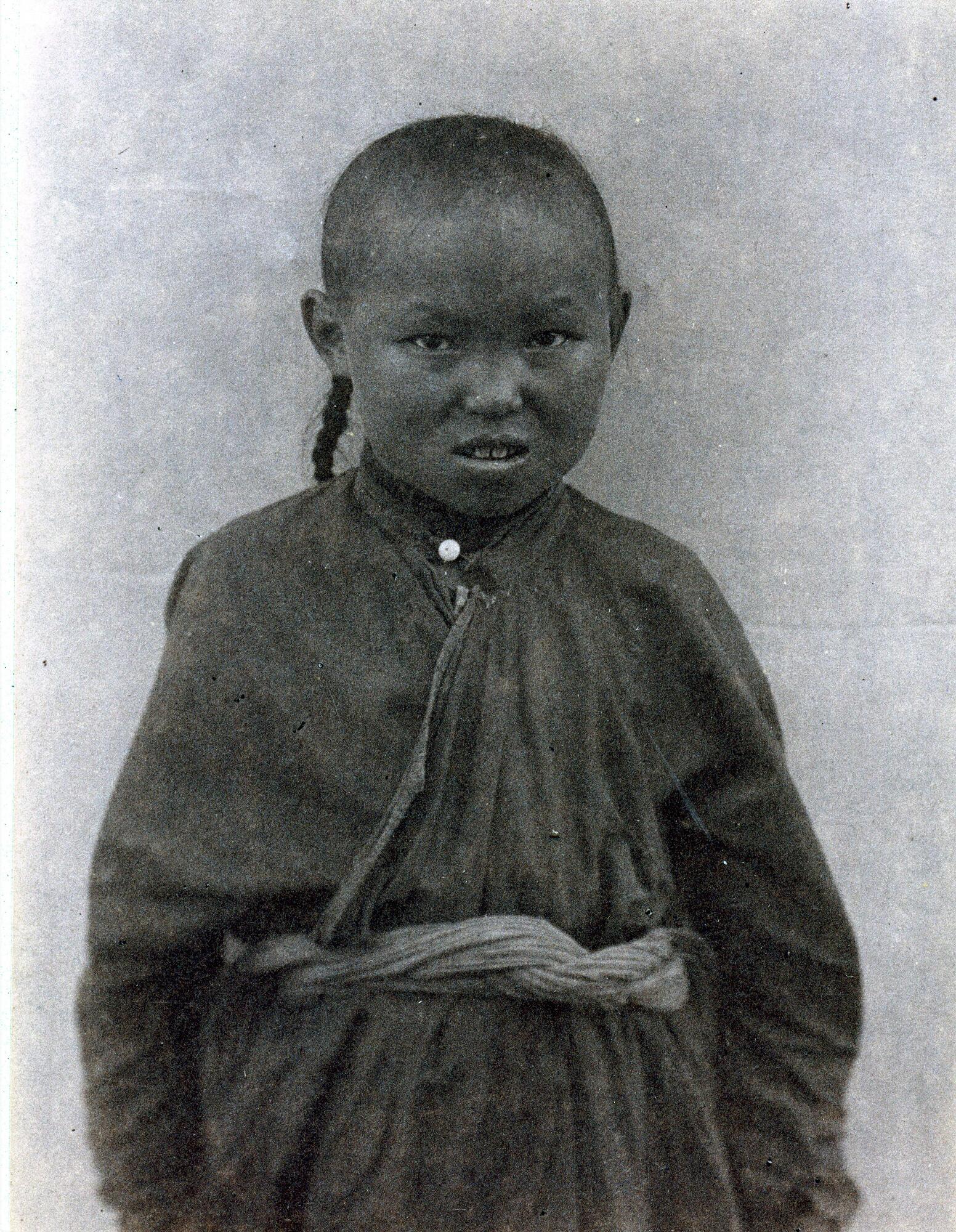The museum collection holds a photograph of a Tuvan boy from the Soyan tribe. He is dressed in national clothes, and on his head, there is a traditional braid called kezhege.
Tuvans of the Soyan tribe live mostly in the Tes River valley of the Erzinsky district. On the right bank of the river, there is a sacred clan mountain — Kezhege, which was considered the main patron by shamans.
The word ‘kezhege’ is translated as ‘man’s braid’. The word is of Old Turkic origin. In the Altai language, the name sounds like kedyege, and in Mongolian, it sounds like gezeg.
Tuvans considered this ancient male hairstyle a symbol of bravery and strength. The thicker the braid was, the more respected its owner was.
The traditional kezhege hairstyle was also mentioned in folklore. For example, in Tuvan fairy tales, a braid from a defeated nemesis’s head served as proof of victory, as in the case with one of the heroes, called Ertine-Mergene, ‘he tore the kezhege from Kara-Khurume’s head, dug a pit of sixty sazhens, threw the enemy into it and covered the pit with the Bosh Mountain.’
Tuvan boys and girls under the age of three could be distinguished only by the presence of jewelry. Before that time, children did not have their hair cut. The hair was believed to possess powerful protective energy. According to Tuvan beliefs, up to the age of three, which includes the time spent in the womb, a child was protected by god.
When children reached the age of three, they went through a ritual of hair cutting, which had a sacred meaning for Tuvans. The ceremonial details of the ritual were passed down from generation to generation. The first haircut was considered as getting rid of “pre-natal hair”, an initiation ritual that allowed children to leave behind the status of a “divine child” and pass into the world of their families. From that moment on, their lives were no longer the responsibility of higher powers, but the family.
The boys had their hair shaved off, except for strands of hair that were left on the top of the head, which were braided and tied with blue lace. For Tuvans, this color symbolized male well-being.
This ritual was compulsory. In Tuva, the male line was of great importance, so kezhege was braided for the clan chain to continue safely with no interruptions.
Originally, the kezhege braid was to be worn by every Tuvan man. Since 1911, this tradition became voluntary. In the 1950s, men with braids were rare. But since the end of the 20th century, after the collapse of the Soviet Union, the almost lost traditional hairstyle culture, including kezhege, began to revive. Nowadays, braids are popular among creative people, especially musicians and Tuvan throat singers.
Tuvans of the Soyan tribe live mostly in the Tes River valley of the Erzinsky district. On the right bank of the river, there is a sacred clan mountain — Kezhege, which was considered the main patron by shamans.
The word ‘kezhege’ is translated as ‘man’s braid’. The word is of Old Turkic origin. In the Altai language, the name sounds like kedyege, and in Mongolian, it sounds like gezeg.
Tuvans considered this ancient male hairstyle a symbol of bravery and strength. The thicker the braid was, the more respected its owner was.
The traditional kezhege hairstyle was also mentioned in folklore. For example, in Tuvan fairy tales, a braid from a defeated nemesis’s head served as proof of victory, as in the case with one of the heroes, called Ertine-Mergene, ‘he tore the kezhege from Kara-Khurume’s head, dug a pit of sixty sazhens, threw the enemy into it and covered the pit with the Bosh Mountain.’
Tuvan boys and girls under the age of three could be distinguished only by the presence of jewelry. Before that time, children did not have their hair cut. The hair was believed to possess powerful protective energy. According to Tuvan beliefs, up to the age of three, which includes the time spent in the womb, a child was protected by god.
When children reached the age of three, they went through a ritual of hair cutting, which had a sacred meaning for Tuvans. The ceremonial details of the ritual were passed down from generation to generation. The first haircut was considered as getting rid of “pre-natal hair”, an initiation ritual that allowed children to leave behind the status of a “divine child” and pass into the world of their families. From that moment on, their lives were no longer the responsibility of higher powers, but the family.
The boys had their hair shaved off, except for strands of hair that were left on the top of the head, which were braided and tied with blue lace. For Tuvans, this color symbolized male well-being.
This ritual was compulsory. In Tuva, the male line was of great importance, so kezhege was braided for the clan chain to continue safely with no interruptions.
Originally, the kezhege braid was to be worn by every Tuvan man. Since 1911, this tradition became voluntary. In the 1950s, men with braids were rare. But since the end of the 20th century, after the collapse of the Soviet Union, the almost lost traditional hairstyle culture, including kezhege, began to revive. Nowadays, braids are popular among creative people, especially musicians and Tuvan throat singers.



